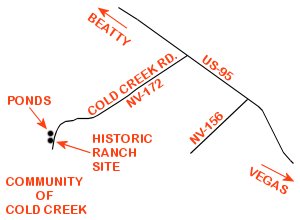Cold Creek
Wild Horses
One of the best places (historically) to see wild horses near Las Vegas is about 1 hour northwest of the city near the community of Cold Creek.
These horses are descendent's of animals that were lost or abandoned by settlers, ranchers, prospectors and Native American tribes in this region.
Today's wild horse reflects characteristics of color, size and ancestral breeding of those animals brought here during the settlement of the West.
Wild horses form small bands or family groups consisting of a dominant stallion (male) and mare (female), with other mares and offspring.
Young males are forced to leave the group at about 2 years of age and join "bachelor" bands with other males.
Within these family units you may notice mares with marks on the left hip or shoulder.
These "freezemarks" are from a fertility control vaccine intended to slow population growth and do no harm to the animals.
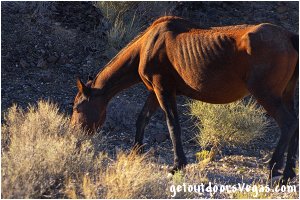
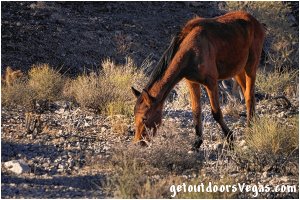
In the past and as recently as the spring of 2018 federal authorities have captured wild horses in the Cold Creek area due to overpopulation, health and environmental concerns.
As seen in the photos above, many of the wild horses are emaciated due to poor range conditions and at risk of starvation.
Captured horses are trucked to Bureau of Land Management (BLM) holding facilities (some were put down because they were too emaciated to save) to prepare for adoption or long-term "housing".
Of those taken none will be returned to the wild.
According to the BLM, the 370,000-acre Wheeler Pass Joint Management Area which includes the area of Cold Creek can sustain no more than a total of 65 wild horses and 35 wild burros.
In response, many residents in the area are sorry to see the horses go but realize the need for rescue due to the poor health and overpopulation of the herds.
Others have angrily opposed the "roundups" and reject the reasoning given by federal land managers.
In the future, this "culling" of the existing population will result in smaller / healthier sustainable herds in this arid land, with sightings becoming rare but very special.
The Cold Creek area, rising to approximately 6,500 feet in elevation, is a breathtaking / picturesque high mountain desert environment.
A place of wide open spaces with sparse vegetation, backdropped by the Spring Mountain Range with elevations rising to 13,000 feet.
Along the road there are open vistas in every direction giving the visitor a "glimpse of the past", a chance to see wildlife and many photo opportunities.
The road, lined with creosote plants and rabbit brush transitions through a Joshua tree forest into a scrub pine forest near the community of Cold Creek.
One of the interesting stops along Cold Creek Road is the Cold Creek Ranch Historic Site. Foundations of the buildings are still there, and Cold Creek itself runs directly through the property.
The ranch lies along a "historic" route over the Spring Mountains through Wheeler Pass which connected outposts and mining camps on both sides of the mountains.
Now under federal jurisdiction (not much information is published) this historic ranch site is preserved for future generations.
In the 1930's the ranch served as a "dude ranch" where women would stay for six weeks in order to obtain Nevada residency and gain eligibility for divorce.
In the 40's there was a working horse ranch near the creek where feral horses were rounded up, branded and sold.
In the late 40's a wildlife biologist stayed at the ranch while working out of the Desert Game Refuge headquarters at Corn Creek.
Later the BLM took over the ranch, utilizing the buildings to house rangers and in the late 70's designated the site as a picnic area.
Today the Forest Service currently manages the site. Just north of the site are three small ponds, fed by springs (Cold Creek) that originate from the mountains.
These ponds being waterholes for a wide variety of endemic desert species and areas for potential sightings of wild horses.
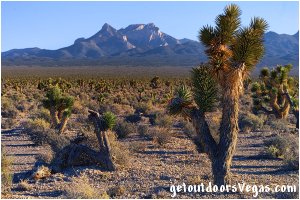
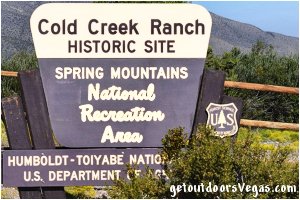
Tips:
IT IS ILLEGAL TO FEED WILD HORSES / BURROS
Be careful, watch for wild horses (or other wildlife) on the road.
Keep an eye out for elk, deer, coyote, rabbits, birds and other animals (be mindful of snakes).
Respect any animals you may encounter, enjoy them from a distance.
Make sure you have a full tank of gas, bring plenty of water and snacks.
Don't forget your camera, binoculars are handy if you have a pair.
Best wildlife viewing early-morning or late-afternoon.
Directions:
From the northwest side of Las Vegas, head North on US-95 for about 15 miles to the "exit" for NV-156.
Continue North on US-95 for 5.5 miles (check your odometer) to NV-172.
Head South on NV-172 (Cold Creek Rd) towards the community of Cold Creek.
The wild horses can be seen from about 4 miles South of US-95 to just shy of the community of Cold Creek (please respect the residents of this community).
At a point approximately 13.2 miles South of US-95 (along the paved road and on your right) is the Cold Creek Ranch Historic Site facility / parking area.
From the parking area, approximately 500 feet North are 2 ponds that are frequented by wild horses (a third pond being 1800 feet further North).
Dirt roads leading to the ponds may be passable in favorable weather.
Return by reversing route.
Approximately 55 miles from central Vegas Strip to the historic ranch site.
